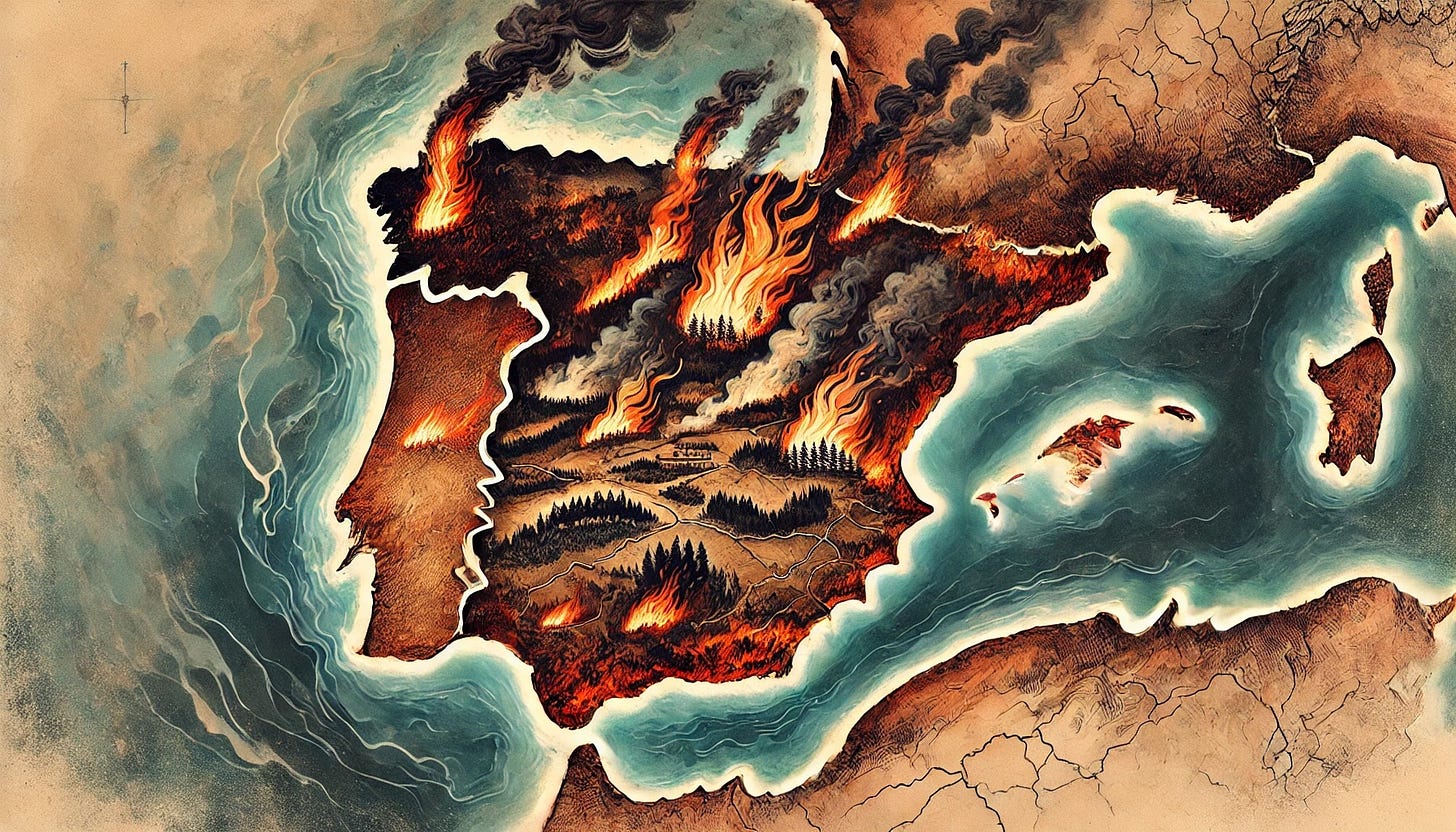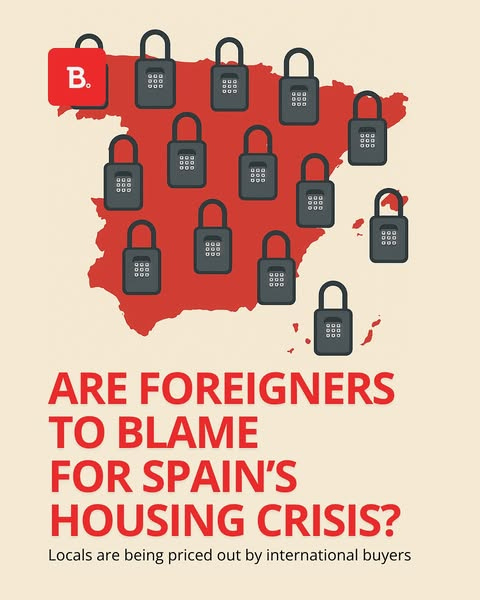🔥 Spain Is Burning
Plus: Correos suspends shipments to the U.S., Belén Esteban returns, and a crazy clandestine zoo bust.
Madrid | Issue #114
🇪🇸 The Bubble is Spain's #1 English-language, best-selling newsletter. We offer paid subscriptions, and we’d be thrilled to have your support!
🚨 Big news! Over the next several weeks, we will be rolling out several new products for our paid subscribers ❤️. Starting next week, The Bubble will begin to publish in Spanish. A week later, we’ll publish our next deep dive into Spain’s real estate market. And then later this fall, a guide on getting a Spanish visa, and a podcast.
It’s getting hot in here
🧑🚒 Spain is having the biggest fire season ever. Let’s fight about it
Even if you’ve been 100%-brain-dead-on-vacation since late June, you’ve probably heard: Spain is on fire. Like, literally. Forests and scrublands have been going up in flames while you’ve been sipping tinto de verano at the beach. True, “only” 0.8% of the country has burned to a crisp—but that’s more than 400,000 hectares which, trust us, is a LOT. The smell of smoke in Galicia and on the Castilla y León meseta is now basically part of the local terroir. Spain right now? Call it Naturaldisasterstan.
Those statistic things. The EFFIS (European Forest Fire Information System) counts 19 of the 50 largest fires of the past decade occurring in Spain in just the last two weeks. It also estimates that so far this year over 408,000 hectares have been burnt in Spain, putting it well on the way to beating the three record years it set in the 1990s.
Where it’s worst. Galicia and Castilla y León account for three-quarters of all burned Spain this year, with León (15% scorched) and Ourense (7%) leading the misery parade. Fires in Larouco (Galicia) and Uña de Quintana (Zamora) are now the largest ever recorded in Spain since EFFIS started perimeter tracking in 2016, only rivaled by the 2022 infernos in Zamora’s Sierra de la Culebra.
The Euro picture. Spain alone makes up 40% of all EU land burned in 2025. Add Portugal—where 240,000 hectares went up in smoke in just two weeks this August—and the Iberian peninsula accounts for two-thirds of Europe’s scorched earth. The continent has already lost more than a million hectares to flames this year, topping the previous record set in 2017, and definitely more than when you accidentally dumped a bottle of Roundup on your parents’ yard 🤦.
Wildfire meets dumpster fire. It took a while for Spain’s politicians (just like you) to notice that half the country was on fire — mostly because August is sacred vacation time. But once they stored away their swimsuits and returned to the stage, they (as expected) joined together to unite the country in times of emergency started fighting like school children.
Prime Minister Pedro Sánchez attempted to sound, like, statesmanlike. During visits to Asturias and Galicia, he promised solidarity, resources, and above all a push for a “pacto de Estado” — a sort of cross-party agreement to deal with…climate change (not, specifically, natural disasters).
This is a pretty bauble.
SánchezMr Handsome offered no specifics on what that would actually mean, making it look like maybe a balloon of hot air designed to distract from government failures and make hisrespected oppositionhated opponents look bad (because, like, who could be against a pact to deal with climate change?). He said his idea was to hammer out a deal at the next Conference of Regional Presidents (to be held before 2025 ends).
A love-in…NOT. Meanwhile, the center-right Partido Popular (PP) responded by agreeing with Sánchez on everything he said…LOL! Kidding.
You guys are the worst. The PP basically accused the Sánchez’s PSOE government of sucking at dealing with emergencies. First, party spokespeople attacked the government for “dragging its feet”, for failing to deploy resources quickly enough, and for the PM himself arriving late to the disaster zones. They also called the government’s Emergencies Director (like the FEMA boss in the U.S.) a “pyromaniac” and a partisan “hooligan”.
Pretty pix. In the PP’s telling, the central government was negligent, partisan, and more concerned with photo ops than with firefighting.
Feet of clay. The slow-moving PP boss Alberto Núñez Feijóo took a possible political winner and fumbled it (again) by floating a proposal that sounded more sci-fi than feasible: the creation of a national database of “pyromaniacs,” complete with geolocating ankle bracelets. Why? He claimed 80% of fires are intentionally set.
Think Spain’s answer to Minority Report, but for rural arsonists. The problem? The data simply don’t support his premise. Official figures from 2023 show that only 7.6% of fires are deliberate, far from the 80% figure Feijóo liked to quote.
Maybe…? Feijóo’s “incendiary terrorism” narrative may be meant to shift blame away from the PP-led regional governments responsible for forest management in the affected zones. 🤔
So… will Sánchez’s “pacto de estado” get anywhere? Well… let’s say we wouldn’t bet on it. But watching the catfight will be fun.
More news below. 👇👇
🔔 But first, check out our Instagram account
If you’re not following us on Instagram yet, you’re missing out. We’re posting exclusive content with our collaborators across Spain, breaking news updates, and pop culture coverage. Click on the post above and come hang with us!
💬 Five things to discuss at dinner parties
1. 📦 Correos to U.S.: Return to sender
Didn’t get that package off to the U.S. before Monday? Well, you’re SOL (yeah, shit outta luck). Correos, Spain’s state postal carrier, has suspended shipments of goods to the U.S. worth between $100 and $800.
Why? Because Trump. The Big Orange used a July 30 executive order to kill off something called de minimis exemption—a handy little loophole that allowed low-value packages (under $800) to enter the U.S. without tariffs.
The idea behind de minimis is simple. It generally costs more to collect tax on a $50 pair of socks than the tax itself is worth. So the U.S. (like the EU, which exempts packages under €150) lets the small stuff slide. E-commerce giants like Temu and Shein built empires on it, and countless small European businesses quietly relied on it too.
Not anymore. Starting Aug. 29, those $100–$800 parcels get hit with a 15% tariff at the border. Correos says it wasn’t given enough time to build the systems to collect duties in advance, so—for now—it’s just refusing the shipments altogether. Letters, books, and personal gifts under $100 can still go, but anything commercial in that middle value range? SOL.
And it’s not just Spain. Postal operators from Germany’s DHL to France’s La Poste, Austria’s Österreichische Post, Sweden’s PostNord, and even Britain’s Royal Mail are all slamming the brakes on U.S.-bound packages until they can figure out how the f&$% to comply.
No time. European operators complain they had only two weeks’ notice before the rule change—confirmed Aug. 15 and in force by Aug. 29. DHL put it bluntly: nobody knows who’s supposed to collect the tariffs, how the data is supposed to be transmitted, or how customs clearance will work. So until the paperwork catches up with the Big Pumpkin’s pen, the safe play is to stop shipping.
The scale of what’s at stake is gigantic. According to U.S. Customs and Border Protection, a whopping 1.36bn packages entered the country under de minimis last year, with goods worth about $64.6bn. That’s almost 4 million packages a day, suddenly shoved into tariff limbo.
Tough for the little guy. For Spanish businesses that depend on Etsy, Shopify, or direct e-commerce to the U.S., this is a major headache. For American consumers who like buying a €220 leather bag from a Madrid artisan, or €500 worth of abanicos imprinted with Belén Esteban’s face (don’t judge), it means higher prices—or nothing arriving at all.
Soonish? Correos says it will restart shipments in “the shortest period possible.” No word on when.
2.👸🏻 The return of Belén Esteban: Spain’s patron saint of reality TV is back (again)
We know you may not care about Belén Esteban. Sure, her fortunes on screen may appear trivial, but they serve as a barometer of gossip, melodrama, and scandal broader cultural tastes. She will not be ignored!
Tears shed. It was only two months ago that we broke the sad news that her show on TVE was being canceled. Yet, in a testament to the resilience of Spanish daytime television and of Esteban herself (often dubbed the “princess of the people”), she is already returning to the medium that made her famous: the afternoon talk show. Repent, fools!
Belén Esteban returns to the small screen starting Monday, alongside the legendary María Patiño and Carlota Corredera in No Somos Nadie, a brand-new daily talk show on the TEN network.
The show will air weekdays for (hurray!) a jaw-dropping four hours a day. Belén will do what she does best: be herself (which translates into screaming, eating on the air, yelling personal anecdotes, and the sharp analysis and commentary á la TMZ that’s made her a household name for nearly two decades).
TEN is a modest digital channel that’s become something of a rehab clinic for fallen TV stars, and, after their failed TVE experiment, it’s providing Esteban and Patiño (again) with a platform to return to our hearts.
So why does this matter? Because Belén Esteban and María Patiño are Spanish pop culture. Esteban isn’t just a TV collaborator; she’s a national archetype.
Belén is you! She’s the everywoman who turned heartbreak, family drama, and outrageous one-liners into a media empire, complete with branded potato crisps and gazpacho (the latter of which, tellingly, folded this week 😕). Patiño, meanwhile, is her perfect partner: a fast talker with a journalist’s instinct for scandal.
Together, they’ve defined what Spanish daytime gossip looks and sounds like for an entire generation. And hundreds of thousands of people go on TEN or YouTube to watch them scream at each other live for four hours every afternoon.
When Belén Esteban speaks, you should pay attention. Resistance is futile.
3. 🎖️ How far we’ve come (no, seriously)
José María Sánchez Silva died Monday in a military residence outside Madrid. But he wasn’t just another retired officer: in 2000, the lieutenant colonel in the Armed Forces’ legal corps became the first high-ranking member of Spain’s military to come out of the closet.
Breaking through. Back then, Spain’s same-sex marriage law was still five years away, the word “Pride” conjured more sneers than sponsors, and Spain was only a generation removed from Generalísimo Franco’s 39-year ban on, well, pretty much everything fun. For a military man to pose on the cover of Zero magazine (an LGBT-themed mag that ran 1998-2009) under the headline “The First Gay Soldier” was kind of an earthquake.
The story began not in the barracks, but in Chueca’s famous gay Berkana bookstore. Sánchez Silva, then 49, confided his secret to owner Mili Hernández, who put him in touch with Zero, El País writes in its very good obituary. Soon after, he sat for interviews with both the magazine and El País: “The correct thing would be discretion. But silence means renouncing our rights, suffering in silence, staying locked away.”
The backlash came quickly. The Ministry of Defense sniffed that his private life was “inconsequential.” He endured insults and threats, and a fellow officer left a note on his desk calling homosexuality worse than “the Four Horsemen of the Apocalypse together.” He knew his military career was over when, after he filed a court complaint against the author of that note for slander, the army said the letter did not constitute a disciplinary offense.
No more. By 2004, discredited in the eyes of the military, Sánchez Silva requested early retirement. But he refused to become embittered: “If anyone has hated me, let them know, right now, that they have not succeeded in making that hatred reciprocal.”
History moved faster than his career. Spain legalized same-sex marriage, and Madrid became one of the world’s gay capitals, and now throws a Pride party that now rivals São Paulo or San Francisco. The irony is hard to miss: under a wee little general named Franco, gay men were jailed and “re-educated.” Forty years later, Madrid’s Castellana and Gran Vía flood each July with rainbow flags, drag queens on floats, and half a million tourists ordering gin tonics in Chueca.
Sánchez Silva didn’t keep his medals or his uniform after he left. His later years were quiet—a home in Chamberí (we like him even more!), meals at El Yate, strolls back to Chueca to buy books at Berkana—but his act of defiance left a mark larger than any rank could bestow.
The world still isn’t perfect. Discrimination hasn’t vanished, and progress always feels fragile. But one life—lived bravely, at great personal cost—reminds us just how far we’ve actually come.
4.📺 Simón Pérez & Silvia Charro kicked from Kick: A Black Mirror episode nobody asked for
Warning: this story is sad.
Few viral careers better capture the dystopian side of internet fame than that of Simón Pérez and Silvia Charro. Their story reads like a lost, depressing episode of Black Mirror: two minor financial consultants record a video, go viral for all the wrong reasons, lose everything, and then reinvent themselves by monetizing their own self-destruction online.
It all started back in 2017. Then, the pair uploaded a YouTube video titled “¿Por qué las hipotecas fijas son tan convenientes?” (see video above). Instead of financial wisdom, viewers got something else entirely: two visibly intoxicated (and, by their own later admission, coked-up) presenters slurring their way through mortgage advice. The clip went viral immediately, not because anyone cared about fixed-rate loans, but because the spectacle was too sad and weird to ignore.
The fallout was immediate. They lost their jobs, their reputations, and any semblance of professional credibility. But we are living in strange times, and thanks to the twisted economy of internet attention, Pérez and Charro managed to turn that downfall into a business model.
They became streamers (shocker), reinventing themselves across platforms such as YouTube, Twitch, or Kick, catering to an audience that paid not for advice, but for entertainment and chaos.
On their Kick channel SS Conexión, donations flowed live in exchange for increasingly extreme stunts: from binge drinking to drug use to acts of humiliation (€100 for consuming drugs on camera). El Español wrote about them earlier this month and called it “the live streaming of a ‘suicide’”.
But their “anything for clicks” strategy finally hit a wall this month. After the tragic death of French streamer Raphaël Graven (aka Jean Pormanove) during a 12-day Kick livestream (an incident that has triggered investigations in France), the platform expelled Pérez and Charro.
Going straight. For Kick, which had long branded itself as the “permissive” alternative to Twitch, the crackdown was a rare moment of restraint. For Pérez and Charro, it was the end of their last major refuge.
Or at least, almost. The pair have already dusted off their old YouTube channels, where they announced they’ll continue streaming, though they admit they’ve “lost all their traffic along the way.” Their real plan, however, is to move to Trovo (a smaller live-streaming platform owned by Chinese tech giant Tencent, pitched as a mix between Twitch and YouTube Gaming). Think of it as the streamer world’s bargain-basement afterparty.
For now, Pérez and Charro are clinging to the only asset they have left: notoriety. “We’ve got no money,” they admitted in a recent broadcast. But in the attention economy, being broke has never stopped anyone from streaming.
5. 🦦 You’re not from around here, are you?

Guardia Civil agents knew they were onto something when they found a makeshift animal preserve in a Castellón small town packed with scores of animals that had starred in David Attenborough nature documentaries that definitely did not have the word “Spain” in the title.
Agents stumbled across the clandestine zoo after spotting an online ad offering exotic “pets” that looked suspiciously like they belonged in rainforests or savannas. The seller was hawking Asian otters, kinkajous, and agoutis, and even boasted of breeding meerkats, kangaroos, and caracals. That’s when the Guardia hit play on some videos of the supposed “farm” and found an even stranger cast: leopards, owls, llamas, and ibis.
The trail led them to a property in Nules (the town known for breeding Spain's most popular Clementine), where they found a makeshift menagerie in cages, barns, and sheds. None of the animals were registered, and — shocker! 😱— the two men arrested (ages 30 and 35) lacked both a breeder’s license and authorization to run a zoo.
Inside were more than 150 animals from 56 different species, spanning all five continents. Think: zebras, servals, crowned cranes, turacos, possums, bighorn sheep, macaws, porcupines, and, for some reason, a dromedary. Two of the macaws even turned out to have been stolen in Almería. 🤷
But the real headline acts were the endangered ones! There were two ring-tailed lemurs (from Madagascar the island—and yes, also Madagascar the movie); two Asian small-clawed otters (the world’s smallest otters — and so cute!); and one Bali starling, a snowy white bird so rare there are fewer than 100 left in the wild.
That’s when the Guardia Civil said, “Damn, you really aren’t from around here.” (Fine, they didn’t.)
The men are now under investigation for wildlife trafficking and contraband, with the average market value of the seized animals estimated at nearly €70,000 (‼️). The animals themselves were handed over to experts from the Environment Ministry.
If you really want to see some Asian small-clawed otters — but, like, legally — head to Terra Natura Zoo in Benidorm. (And no, we’re not using “Asian small-clawed otters” as a euphemism for “really drunk Brits,” though you’ll find plenty of those in Benidorm too.)
🙏 Once again, please remember to share this newsletter with your friends on social media. The more we grow, the more information we’ll be able to offer each week.
We’ll be back next week with more.






